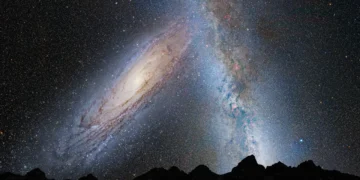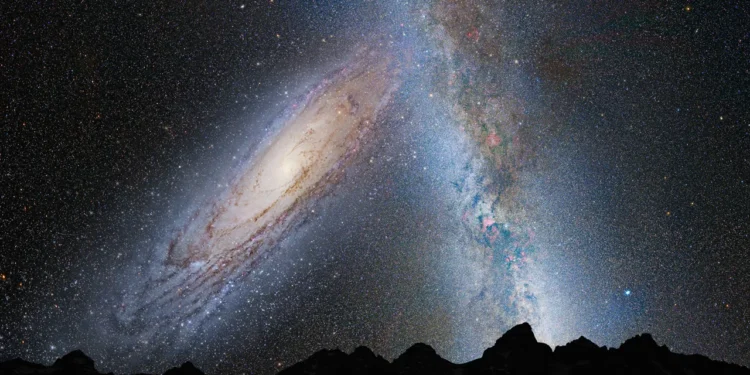Dark energy, a mysterious force accelerating the universe’s expansion, has perplexed scientists since its discovery. Traditionally, measurements from the Cosmic Microwave Background (CMB) and distant supernovae have been our primary tools to understand dark energy. However, a recent study led by Dr. David Benisty and his collaborators, Anne-Christine Davis and Wyn Evans proposes a novel method: using the dynamics of the Local Group of galaxies, particularly the Milky Way (MW) and Andromeda (M31), to place new constraints on dark energy. This approach not only provides an independent way to probe the universe’s expansion but also holds the potential to test alternative theories of gravity.
A New Approach to Constraining Dark Energy
The dynamics of the Local Group, especially the gravitational interplay between the Milky Way and Andromeda, present a new avenue to understand dark energy. Researchers have modeled this interaction using two cosmological models, McVittie (McV) and De Sitter-Schwarzschild (DsS) spacetimes. By analyzing the galaxies’ past separations and velocities, they aim to predict how dark energy influences their dynamics over time. Unlike traditional methods relying on observations from distant regions of the universe, this approach uses the “Timing Argument” to estimate the mass of the Local Group (LG) and test its dependency on different cosmological constants.
The study found that the predicted mass of the Local Group varies significantly depending on the assumed value of dark energy. Under the influence of the repulsive force generated by dark energy, a stronger gravitational attraction (and thus, a higher mass) is required for the galaxies to have approached each other as they did. The model that embeds the Local Group in an expanding universe suggests a lower mass than purely Newtonian models. This variation is critical because it allows scientists to compare different scenarios and fine-tune our understanding of dark energy’s role in cosmic dynamics.
Results: Dark Energy’s Fingerprint on the Local Group
The results of the study are groundbreaking. By using Local Group dynamics, the researchers have provided an upper bound for dark energy that differs from the current values derived from the CMB data provided by the Planck satellite. The study suggests that under certain assumptions, the Local Group’s constraints on the cosmological constant (Λ) are more restrictive than those obtained from large-scale cosmic observations. This is important because it validates the use of local astrophysical systems as tools for cosmological measurements, providing an independent check on our understanding of dark energy.
Moreover, the study showed that future astrometric data from telescopes like the James Webb Space Telescope (JWST) could significantly tighten these constraints. With JWST’s high-precision astrometry, it will be possible to measure the positions and motions of the Local Group’s galaxies with unprecedented accuracy. This, in turn, will allow for even more refined estimates of dark energy’s effects on the Local Group. The researchers argue that such advancements could lead to constraints that are potentially much tighter than those currently provided by the Planck data, offering a powerful new way to probe the universe’s expansion.
Beyond Dark Energy: Testing Alternative Theories of Gravity
The Local Group dynamics offer more than just a window into dark energy; they also provide a platform to test alternative theories of gravity. In addition to constraining the cosmological constant, the study explores modified gravity theories, such as scalar-tensor theories, that could explain cosmic acceleration without invoking dark energy. These theories predict different gravitational behaviors on the scale of galaxies compared to what is expected in our solar system.
Using the Local Group as a laboratory, researchers can derive bounds on these theories over Megaparsec scales. While the constraints are not as stringent as those obtained within the solar system, they are the first to test these theories on such large scales. This is crucial because it allows scientists to explore the consistency of modified gravity theories in different cosmic environments. If future data from JWST and other observatories align with these theoretical predictions, it could lead to a paradigm shift in our understanding of gravity and cosmic acceleration.
Why This Matters: The Broader Implications for Cosmology
So why is this study so important? First, it provides a new way to measure one of the most mysterious forces in the universe—dark energy. By using the Local Group’s dynamics as a natural laboratory, scientists can cross-check their findings against more traditional methods, such as CMB measurements. This cross-validation is critical in science, as independent lines of evidence can strengthen or challenge prevailing theories.
Second, the study opens up new possibilities for future research. With the upcoming astrometric data from JWST and other telescopes, we can refine these constraints and explore new parameters. This could lead to a more precise understanding of the universe’s fate and the nature of dark energy. The study also encourages the exploration of modified gravity theories, pushing the boundaries of what we know about fundamental physics.
Lastly, this research exemplifies the power of innovative thinking in science. Instead of relying solely on distant cosmic observations, it uses our local cosmic neighborhood—the Local Group—to answer some of the most profound questions in cosmology. This approach could be applied to other cosmic systems, leading to new discoveries and insights into the universe’s most elusive components.
The Path Forward: Future Observations and Challenges
While the study’s findings are promising, they also highlight several challenges. Measuring tangential velocities and cosmic biases with high precision is not easy. Current uncertainties in these parameters mean that the predicted masses of the Local Group under different dark energy models are not yet distinct enough to draw definitive conclusions. However, future observations are expected to reduce these uncertainties significantly.
In conclusion, the recent study on dark energy constraints from the Local Group of galaxies is a significant step forward in cosmology. By using the dynamics of the Milky Way and Andromeda, scientists have found a new way to probe dark energy and test alternative theories of gravity.
As we look to the future, the potential for new data and refined models offers hope that we will soon unlock more of the universe’s secrets. Whether through better understanding dark energy or challenging our current theories of gravity, the Local Group’s study is a testament to the ever-evolving nature of scientific exploration. It’s an exciting time for cosmologists and anyone fascinated by the mysteries of the cosmos.
Reference:
Dark Energy Constraints from Different Local Group Histories” by Benisty et al., published on arXiv. This paper discusses a novel approach to constraining dark energy using the dynamics of the Local Group of galaxies, specifically focusing on the interaction between the Milky Way and Andromeda. https://arxiv.org/html/2401.09546v3



















